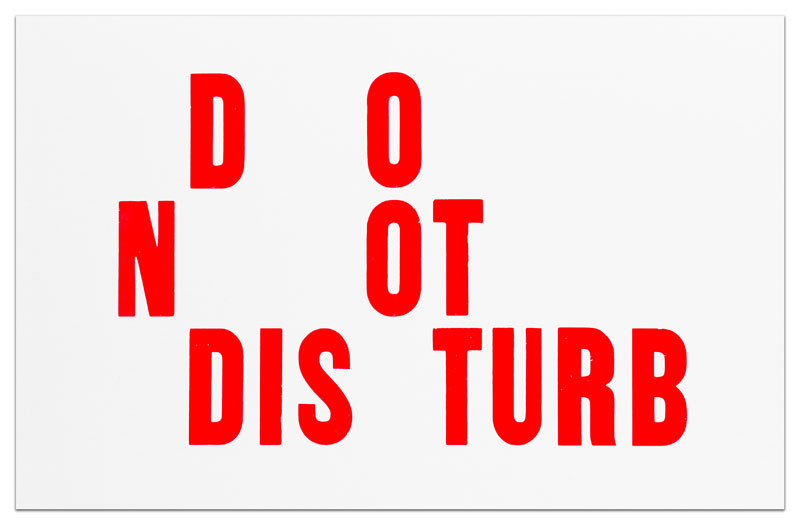
Image/paper size: 14 x 22 inches (35.6 x 55.9 cm)
Edition of 100
Signed and numbered on reverse in graphite
(Inventory #28849)
Image/paper size: 14 x 22 inches (35.6 x 55.9 cm)
Edition of 100
Signed and numbered on reverse in graphite
(Inventory #28849)
In Kay’s words, “When I read about the creation in the text of Genesis, my thoughts were primarily about the abundance, diversity, and pristineness of life that was created and how impoverished and degraded it has become under our stewardship. We have squandered those remarkable gifts and privilege almost to the point of no return. My contribution to “In the Beginning” concerns this critical issue.”
Through its text and through its form, Do Not Disturb functions as a message and as a metaphor. It carries through it’s message, DO NOT DISTURB, a command to cease the reckless abuse of the earth. Uncannily, the structure of the text verbally mimics the creation. The text contains letters which are capable of grouping themselves into dominant families of D’s. I’s, S’s, T’s, and O’s. Organizing themselves in this way, one letter under the other like letter, they create a system of divisions and classifications of similar forms. This arrangement of text is very closely related to what happens in Genesis and to the methodical order and sequencing, divisions and relationships, as in “each after their kind” and “gathering together unto one place.” The letters simulate an efficient model of Genesis through a process of alignment. At the same time that they comment on the creation, the letters act it out as little verbal surrogates.
Kay Rosen’s investigation into the visual possibilities of language has been her primary focus since 1968, when she traded in the academic study of languages for the study of language-based art. Through paintings, drawings, murals, prints, collages, and videos, Rosen has sought to generate new meaning from everyday words and phrases by substituting scale, color, materials, composition, graphic design, and typography for the printed page.
While political issues often form the bedrock of Rosen’s artwork, she insists that her work is driven not by politics, but by language, and she follows it to whatever place it takes her. Rosen loves the physical act of drawing and painting, and materially her paintings and drawings are intensively rendered; however, she considers language to be found material, conceptually placing her in the more passive role of a cognitive observer and enabler of language. The writer Rhonda Lieberman described her as a revealer of language who “shows it doing things that are totally above, beyond, and/or below its function as a mode of communication.”
Rosen’s work has been described as sculpture, poetry, architecture, and performance. Roberta Smith once called her a “writer’s sculptor” and Eileen Myles called her the “poet of the art world.” In a 2014 piece for Art In America, Rosen wrote: “The linguist in me wanted meaning to be carried by the structure of the words, not type style; the inner painter insisted that color convey meaning; the sculptor in me obsessed about the construction of letterforms through materials and process; and any poetic instincts strove for efficiency.”
Kay Rosen has been the subject of numerous articles, reviews, and group and solo exhibitions, including in 1998 a two-venue mid-career survey entitled Kay Rosen: Li[f]eli[k]e, curated by Connie Butler and Terry R. Myers at the Los Angeles Museum of Contemporary Art and Otis College of Art Design. She has been the recipient of awards that include a Guggenheim Foundation Fellowship in 2017 and three National Endowment for the Arts Visual Arts Grants. Her work is included in many institutional and private collections. Rosen taught at The School of the Art Institute of Chicago for twenty-four years. She was born and raised in Corpus Christi, Texas and lives in New York City and Gary, Indiana.
10 Newbury Street, Boston, Massachusetts 02116
617-262-4490 | info@krakowwitkingallery.com
The gallery is free and open to the public Tuesday – Saturday, 10am – 5:30pm